Cabinet of North Korea
The Cabinet of North Korea (Naegak[1]) is, according to the Constitution of North Korea, the administrative and executive body and a general state-management organ in the Government of North Korea.[2] The Cabinet's principal newspaper is Minju Choson.
| Government overview | |
|---|---|
| Formed | 1948 (current, 2013) |
| Jurisdiction | North Korea |
| Headquarters | Pyongyang |
| Minister responsible | |
| Website | Minju Choson, the official newspaper of the Cabinet |
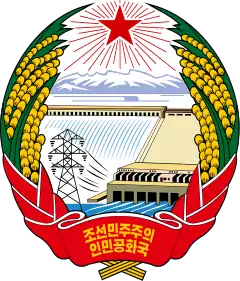 |
|---|
| This article is part of a series on the politics and government of North Korea |
|
|
History
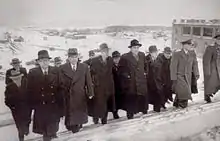
In North Korea's first constitution, adopted in 1948, the executive powers were vested in the Cabinet, chaired by Kim Il-sung himself.
The 1972 constitution saw the establishment of the post of President of North Korea which led the executive branch, and the cabinet was split into two organizations: The Central People's Committee and the State Administration Council. The Central People's Committee provided the highest visible institutional link between the government and the party and served in effect as a de-facto super-cabinet. According to the 1972 constitution, the Central People's Committee exercised various functions and powers such as shaping the internal and external policies of the state, direct the work of the Administration Council and provincial people's committee, supervising the execution of the constitution, laws and ordinances of the Supreme People's Assembly, establish or abolish ministries, executive bodies of the Administration Council and appoint or remove vice premiers, ministers and other members of the Administration Council and also to declare a state of war and enacting mobilization orders in case of emergency. Article 104 gave the authority to the CPC to adopt decrees and decisions and issue directives.[3]
The National Defence Commission was then sub-committee of this body.[4] The CPC's formal powers were all-inclusive and it was chaired by the President.[5] Among its responsibilities are formulating domestic and foreign policies, directing the work of the State Administration Council and its local organs, directing the judiciary, ensuring the enforcement of the constitution and other laws, appointing or removing the vice premiers and cabinet members, establishing or changing administrative subdivisions or their boundaries, and ratifying or abolishing treaties signed with foreign countries. The CPC also may issue decrees, decisions, and instructions. The State Administration Council was guided by the CPC and was led by a premier (chong-ri) and included vice premiers (bochong-ri), ministers (boojang), committee chairmen, and other cabinet-level members of central agencies. It was responsible for the formulation of state economic development plans and measures for implementing them, the preparation of the state budget, and the handling of other monetary and fiscal matters.[6]
1982 saw the People's Armed Forces and Public Security Ministries assigned directly to the President together with the State Inspection Commission.
In 1990, by a CPC decision, the NDC became fully independent from it as a separate institution, and 1992 constitutional amendments assigned it directly to the Supreme People's Assembly. In 1998 amendments to the Constitution, the Central People's Committee and the State Administration were abolished, and the Cabinet was re-created. Thus, the Cabinet is not only the highest executive enforcement organ but was also expanded to become the general State management organ.
Emphasizing its expanded role, on January 1999 Kim Jong-il stated that
"The party organizations and party cadres should not intervene in administrative matters. The party should help the cabinet to be responsible for all economic affairs. Last year we made a new governmental system where the cabinet is supposed to be the control tower of the economy...No organizational unit should handle economic problems without consulting the cabinet".[7]
First cabinet
The first cabinet was announced with the establishment of North Korea on September, 1948[8][9][10]
- Deputy Prime Minister - Hong Myong-hui (洪 命 熹, 1888 ~ 1968)
- Deputy Prime Minister - Kim Chaek (金 策, 1903 ~ 1951)
- Chairman of the National Planning Committee (Jun-taek Jeong, (우}}) (朴一禹, 1911 - 1955)
- National Defence Minister Choe Yong-gon (Korean: 최용건) (1900-1976)
- Internal Affairs Minister Pak Il-u (Korean: 박일우) (朴一禹, 1911 - 1955)
- Foreign Affairs Minister Pak Hon-yong (朴憲英, 1900 - 1956)
- Industry Minister (책 相 兼任) Kim Chaek (金 策, 1903 - 1951)
- Agriculture and Forestry Minister (Pak Mun-gyu, 1906 - ?)
- Transport Minister Chu Yong-ha (朱 寧河, 1908 - ?)
- Finance Minister Choe Chang-ik (崔昌益, 1896 - 1957)
- Education Minister Paek Nam-un (白南雲, 1894 - 1979)
- Justice Minister Ri Sung-yop (Korean: 리승엽) (李承 燁, 1905 - 1954)
- Cultural and Propaganda Minister Ho Jong-suk (許 貞 淑, 1902 - 1991)
- Labor Minister Ho Song-thaek (Korean: 허성택) (許成澤, 1908 - 1958?)
- Health Minister Li Pyong-nam (Korean: 이병남) (李炳南, 1903 -?)
- Urban Management Minister Lee Yong 이용 (李 鏞, 1888 - 1954)
- National Censorship Minister Kim Won-bong (金元鳳, 1898 ~ 1958)
- Minister without portoflio Li Guk-ro (李克魯, 1893-1978)
Selection
The cabinet is appointed and accountable to the Supreme People's Assembly, the North Korean unicameral parliament. The SPA chooses the Premier of North Korea who appoints three vice premiers and the cabinet's ministers. All members of the cabinet are members of the Workers' Party of Korea which rules the country since its establishment in 1948. While the SPA is not in session, the cabinet is accountable to the Presidium of the Supreme People's Assembly.[11]
As of 2000, some 260 people have served as cabinet ministers. Six of them have been women:[12] Ho Jong-suk (Minister of Culture, Justice), Pak Chong-ae (Agriculture), Yi Yang-suk (Commerce, Textile and Paper Industries), Pak Yong-sin (Culture), Yi Ho-hyok (Foodstuff and Daily Necessities Industries), and Yu Gi-jong (Finance).[13]
Powers and responsibilities
The Cabinet, as the executive branch of the North Korean state, is responsible for implementing the state's economic policies, as guided by the Workers' Party. The cabinet is not responsible for defense and security issues, as those are handled by the State Affairs Commission. Thus, the security organizations such as the Korean People's Army, Ministry of Social Security and State Security Department report and subordinated directly to the SAC, whose Chairman holds full power as the supreme leader of the republic and the party and overall commander-in-chief of all uniformed forces. The Cabinet convenes a plenary meeting and an executive meeting.[14] The plenary meeting consists of all the Cabinet members, while the executive meeting is kind of a presidium, and comprises fewer people, including the Premier, vice premier and other Cabinet members whom the Premier nominates. The cabinet forms acts in the form of decisions and directives. In the performance of its mandate the Cabinet is empowered by the Constitution to:[15]
- adopt measures to execute state policy.
- institute, amend, and supplement regulations concerning state management based on the Constitution and ministerial laws.
- guide the work of the Cabinet commissions, ministries, direct ministries and subordinate agencies of the Cabinet and the local people’s committees
- set up and remove direct ministries and agencies, main administrative economic organizations, and enterprises, and adopt measures to improve the State management structure.
- draft the State plan for the development of the national economy and adopt measures to put it into effect.
- compile the State budget and adopt measures to implement it.
- organize and exercise works in the fields of industry, agriculture, construction, transportation, communications, commerce, trade, land management, city management, education, science, culture, health, physical training, labor administration, environmental protection, tourism and others.
- adopt measures to strengthen the monetary and banking system.
- do inspection and control work to establish a state management order.
- adopt measures to maintain social order, protect State and social cooperation body’s possession and interests, and to guarantee citizens’ rights.
- conclude treaties with foreign countries, and conduct external activities.
- abolish decisions and directions by economic administrative organs, which run counter to the decisions or directions made by its members.
Those Cabinet ministries that oversee economic sectors also control groups of industries called "complexes". These complexes consist of partially or fully state-owned industrial facilities like factories, mines, or farms, depending on the sector.[16] At a local level, the Cabinet supervises the Local People's Committees.
Structure
As of 17 January 2021, the Cabinet consists of the following:[17][18][19][20][21][22][23][24]
| Minister | Political party | Position | ||
|---|---|---|---|---|
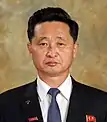 |
Kim Tok-hun | Workers' Party of Korea | ||
 |
Pak Jong-gun | Workers' Party of Korea |
| |
 |
Jon Hyon-chol | Workers' Party of Korea | ||
 |
Kim Song-ryong | Workers' Party of Korea | ||
 |
Ri Song-hak | Workers' Party of Korea | ||
 |
Pak Hun | Workers' Party of Korea | ||
 |
Ju Chol-gyu | Workers' Party of Korea | ||
 |
Kim Kum-chol | Workers' Party of Korea |
| |
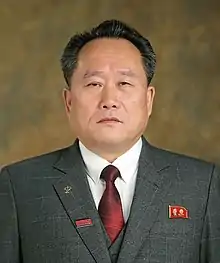 |
Ri Son-gwon | Workers' Party of Korea | ||
 |
Kim Yu-il | Workers' Party of Korea |
| |
 |
Jon Hak-chol | Workers' Party of Korea |
| |
 |
Kim Chung-gol | Workers' Party of Korea |
| |
 |
Ma Jong-son | Workers' Party of Korea |
| |
 |
Jang Chung-song | Workers' Party of Korea | ||
 |
Kang Jong-gwan | Workers' Party of Korea |
| |
 |
Kim Chol-su | Workers' Party of Korea |
| |
 |
Kim Chung-song | Workers' Party of Korea |
| |
 |
Ko Kil-son | Workers' Party of Korea |
| |
 |
Han Ryong-guk | Workers' Party of Korea |
| |
 |
Yang Sung-ho | Workers' Party of Korea |
| |
 |
Kang Chol-gu | Workers' Party of Korea |
| |
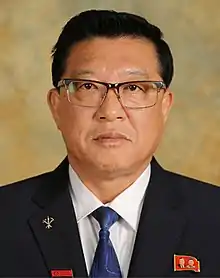 |
Wang Chang-uk | Workers' Party of Korea |
| |
 |
Kim Jae-song |
| ||
 |
Ju Yong-il | Workers' Party of Korea |
| |
 |
So Jong-jin | Workers' Party of Korea |
| |
 |
Ri Hyok-gwon | Workers' Party of Korea |
| |
 |
Jang Kyong-il | Workers' Party of Korea |
| |
 |
Jo Yong-chol | Workers' Party of Korea |
| |
 |
Ri Kang-son |
| ||
 |
Song Chun-sop | Workers' Party of Korea | ||
 |
Ko Jong-bom | Workers' Party of Korea | ||
 |
Jin Kum-song | Workers' Party of Korea | ||
 |
Yun Jong-ho | Workers' Party of Korea |
| |
 |
Ri Chung-gil | Workers' Party of Korea |
| |
 |
Kim Sung-jin | Workers' Party of Korea |
| |
 |
Kim Kyong-jun | Workers' Party of Korea |
| |
 |
Im Kyong-jae | Workers' Party of Korea |
| |
 |
Mun Ung-jo |
| ||
 |
Pak Hyok-chol | Workers' Party of Korea | ||
 |
Kim Sung-du | Workers' Party of Korea |
| |
 |
Ri Kuk-chol | Workers' Party of Korea |
| |
 |
Choe Kyong-chol | Workers' Party of Korea |
| |
 |
Sung Jong-gyu | Workers' Party of Korea |
| |
 |
Kim Il-guk | Workers' Party of Korea |
| |
 |
Choe Song-hak | Workers' Party of Korea |
| |
 |
Ri Chol-san | Workers' Party of Korea |
| |
References
- "The World Factbook". Central Intelligence Agency: Korea, North. 1 May 2018. Retrieved 9 May 2018.
- Article 123 of the Constitution of North Korea
- Dae-Sook Suh & Chae-Jin Lee. Political Leadership in Korea. The 1972 Constitution and Top Communist Leaders, p. 197
- Article 105 of the 1972 Constitution
- Articles 100-106 of the 1972 Constitution of North Korea
- A Country Study: North Korea- 1993- Library of Congress
- Jae-Cheon Lim. Kim Jong-il's Leadership of North Korea, p. 116
- 北韓人民共和國(북한인민공화국) 首相(수상)에 金日成氏(김일성씨) 동아일보 1948-09-10 1면
- 北韓組閣完了(북한조각완료) 동아일보 1948-09-11 1면
- Robert A. Scalapino, Chong-Sik Lee. Communism in Korea: Society. Appendix D- DPRK Cabinet Composition and Membership (1948-1967)
- Article 125 of the Constitution of North Korea
- Lankov, Andrei (2015). The Real North Korea: Life and Politics in the Failed Stalinist Utopia. Oxford: Oxford University Press. p. 28. ISBN 978-0-19-939003-8.
- Park, Kyung Ae (1994). "Women and Revolution in South and North Korea". In Tétreault, Mary Ann (ed.). Women and Revolution in Africa, Asia, and the New World. Columbia: University of South Carolina Press. p. 182. ISBN 978-1-57003-016-1.
- Article 121 of the Constitution of North Korea
- Article 119 of the Constitution of North Korea
- Madden, Michael (16 January 2019). "The DPRK Political Season: Two Post-Mortems". 38 North. Retrieved 19 January 2019.
- "Members of DPRK Cabinet Appointed". KCNA Watch. 18 January 2021.
- "Report on 5th Plenary Meeting of 7th C.C., WPK". KCNA Watch. 1 January 2020.
- New Premier of DPRK Cabinet Appointed
- "Press Release of 8th Congress of WPK". KCNA Watch. 11 January 2021.
- "North Korea picks army man who led Korean talks as top envoy". The Straits Times. Bloomberg. 19 January 2020. Retrieved 19 January 2020.
- "Kim Jong Un sacks foreign minister, says report". Financial Times. Retrieved 2020-01-19.
- Johnson, Jesse (2020-01-19). "North Korea ditches top diplomat in reshuffle that could impact nuclear talks". The Japan Times Online. ISSN 0447-5763. Retrieved 2020-01-19.
- "In full: promotions and demotions at North Korea's 14th SPA". NK PRO. Korea Risk Group. 12 April 2019. Retrieved 17 April 2019.
External links
| Wikimedia Commons has media related to Cabinet of North Korea. |